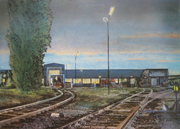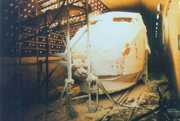Climatic tests on rail vehicles have a long tradition in Austria. The establishment of a climatic wind tunnel for rail vehicles in Vienna in the early 1960s laid the foundations for Rail Tec Arsenal, which has since become a centre of excellence in this field.
The vehicle testing station at the Vienna Arsenal

A rail vehicle testing station for climatic tests has been in operation on the premises of the former Arsenal since 1961. It originated from a joint project involving the Office for Research and Experiments (ORE, Utrecht), the International Railway Union (UIC, Paris) and the Austrian Federal Ministry for Trade and Reconstruction. The Austrian Government contributed the necessary construction site, which offered the unique opportunity to combine the new vehicle testing station with the existing Test and Research Institute for Heating and Refrigeration Technology and Fluid Mechanics based at the Vienna Arsenal. Numerous European railway authorities and the Federal Government were willing to finance the facility on a joint basis.
Construction work on the new vehicle testing station, consisting of one static and one dynamic chamber, began on 18 September 1958. The new facility was put in operation with all due ceremony on 22 June 1961.
In its original configuration, each of the two chambers was designed to produce temperatures from - 40° to + 50°C, the dynamic chamber additionally generating wind speeds of up to 120 km/h at - 15°C. After several upgrades and an extensive redesign in the years 1973/74, the temperature range extended from - 50°C to + 50°C, and the air speed simulating the travelling speed of the vehicle was increased to 250 km/h.
Vienna - centre of excellence for climatic and comfort testing

By the end of 2002, the vehicle testing station at the Vienna Arsenal had been in operation for more than four decades, specialising in the climatic testing of rail vehicles. The facility allowed the weather conditions required for the testing of rail vehicles to be created and if necessary, reproduced in a test chamber at any time. Time and cost-intensive track tests were thus no longer necessary.
The tests were aimed at examining the thermal economy of passenger, special freight and refrigerated rail cars. Work in the vehicle testing station was primarily focused on determining heat consumption, heat losses, heat transfer coefficients and thermal comfort in rail passenger cars. The static chamber was mainly used for functional tests of all relevant rail car system components and for soak tests.
Vienna can look back on a long and internationally recognised tradition as a centre of expertise in climatic and comfort testing of rail vehicles. Many international long-distance and commuter trains passed their final exams in the Arsenal vehicle testing station before being placed on the track, among them the prestigious ICE and TGV high-speed trains.
A long tradition is set to continue

On 31 December 2002 the vehicle testing station on the Arsenal premises was closed down after more than 41 years of operation. At that time the newly erected climatic wind tunnel in Vienna/Floridsdorf had already been completed on schedule to continue the research and testing activities without interruption. It was clear from the beginning of the project that even the most cutting-edge facility would not be sufficient on its own and that the immediate start of testing activities in the new climatic wind tunnel would be inconceivable without experienced staff.
On 1 January 2003 the entire staff of the former vehicle testing station on the Arsenal premises started work at the new climatic wind tunnel in Vienna/Floridsdorf. It was this seamless transfer of executive staff, scientists, project managers and engineers that provided the new climatic wind tunnel with the personnel best suited for the operation of the facility, which is the largest of its kind in the world. In this way it was possible to retain four decades of expertise in thermal passenger comfort, along with the long-standing experience and routine in the performance of climatic tests and the profound know-how required for the operation of such a complex test facility.
Through the erection of the new Vienna Climatic Wind Tunnel and the transfer of Arsenal staff to the new facility, Vienna will retain its position as an international centre of excellence for the certification of rail vehicles and for the performance of functional tests under extreme climatic conditions. A long tradition is set to continue.




